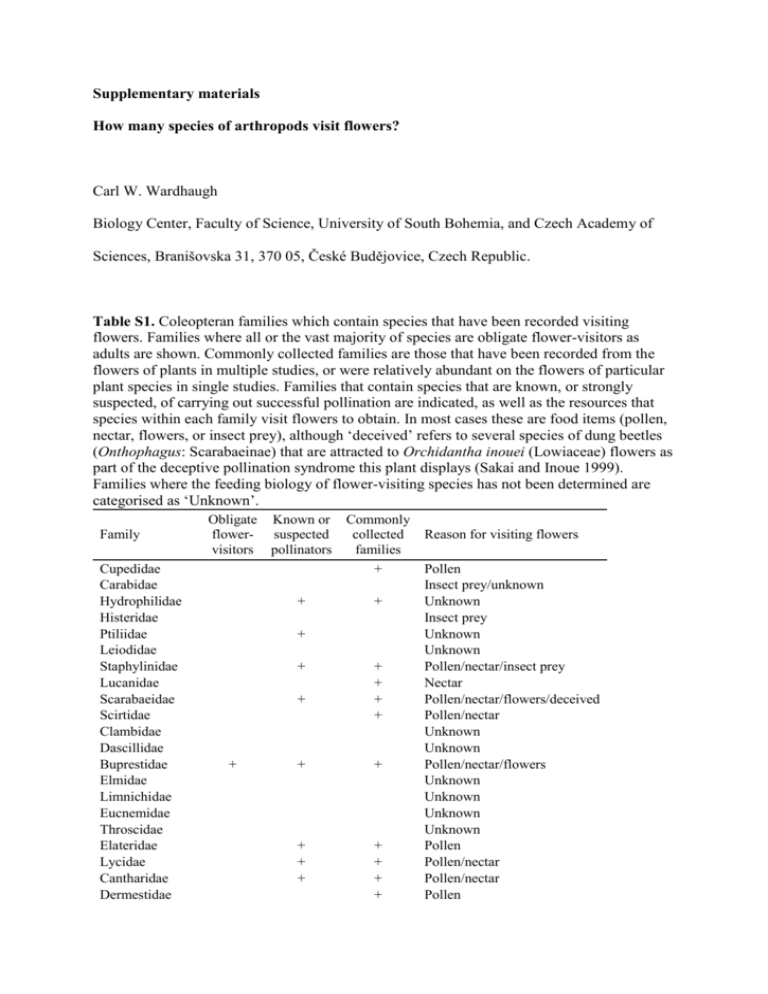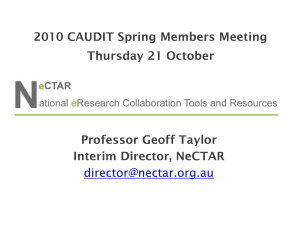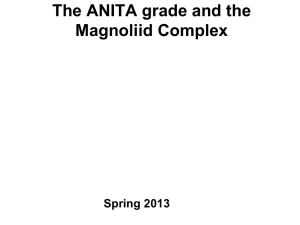Supplementary materials How many species of arthropods visit
advertisement

Supplementary materials How many species of arthropods visit flowers? Carl W. Wardhaugh Biology Center, Faculty of Science, University of South Bohemia, and Czech Academy of Sciences, Branišovska 31, 370 05, České Budějovice, Czech Republic. Table S1. Coleopteran families which contain species that have been recorded visiting flowers. Families where all or the vast majority of species are obligate flower-visitors as adults are shown. Commonly collected families are those that have been recorded from the flowers of plants in multiple studies, or were relatively abundant on the flowers of particular plant species in single studies. Families that contain species that are known, or strongly suspected, of carrying out successful pollination are indicated, as well as the resources that species within each family visit flowers to obtain. In most cases these are food items (pollen, nectar, flowers, or insect prey), although ‘deceived’ refers to several species of dung beetles (Onthophagus: Scarabaeinae) that are attracted to Orchidantha inouei (Lowiaceae) flowers as part of the deceptive pollination syndrome this plant displays (Sakai and Inoue 1999). Families where the feeding biology of flower-visiting species has not been determined are categorised as ‘Unknown’. Family Cupedidae Carabidae Hydrophilidae Histeridae Ptiliidae Leiodidae Staphylinidae Lucanidae Scarabaeidae Scirtidae Clambidae Dascillidae Buprestidae Elmidae Limnichidae Eucnemidae Throscidae Elateridae Lycidae Cantharidae Dermestidae Obligate Known or flower- suspected visitors pollinators + Commonly collected families + + + + + + + + + + + + + + + + + + + Reason for visiting flowers Pollen Insect prey/unknown Unknown Insect prey Unknown Unknown Pollen/nectar/insect prey Nectar Pollen/nectar/flowers/deceived Pollen/nectar Unknown Unknown Pollen/nectar/flowers Unknown Unknown Unknown Unknown Pollen Pollen/nectar Pollen/nectar Pollen Ptinidae Trogossitidae Cleridae Melyridae Boganiidae Byturidae Biphyllidae Erotylidae Monotomidae Cryptophagidae Silvanidae Cucujidae Phalacridae Kateretidae Nitidulidae Endomychidae Coccinellidae Corylophidae Latridiidae Mycetophagidae Melandryidae Mordellidae Ripiphoridae Zopheridae Tenebrionidae Stenotrachelidae Oedemeridae Meloidae Pythidae Pyrochroidae Salpingidae Anthicidae Scraptiidae Cerambycidae Chrysomelidae Nemonychidae Anthribidae Belidae Attelabidae Brentidae Curculionidae + + + + + + + + + + + + + + + + + + + + + + + + + + + + + + + + + + + + + + + + + + + + + + + + + + + Unknown Insect prey/unknown Pollen/nectar/insect prey Pollen/insect prey Pollen Flowers Unknown Pollen Unknown Unknown Unknown Insect prey/unknown Pollen Pollen/flowers Pollen Unknown Pollen/insect prey Unknown Unknown Unknown Unknown Pollen/nectar Insect prey/unknown Unknown Pollen Pollen Pollen Pollen/insect prey Unknown Pollen Unknown Unknown Unknown Pollen/nectar Pollen/flowers Pollen Unknown Pollen Flowers Unknown Pollen/nectar/flowers Table S2. Dipteran families which contain species that have been recorded visiting flowers. Families where all or the vast majority of species are obligate flower-visitors as adults are shown. Families that contain species that are known, or strongly suspected, of carrying out successful pollination are indicated, as well as the resources that species within each family visit flowers to obtain. ‘Deceived’ refers to those species that visit and pollinate flowers that provide no reward, but instead lure these insects by mimicking the smell or appearance of something those species desire, typically rotting meat. Family Limoniidae Tipulidae Ptychopteridae Blephariceridae Psychodidae Chaoboridae Culicidae Thaumaleidae Simulidae Ceratopogonidae Chironomidae Anisopodidae Scatopsidae Bibionidae Mycetophilidae Sciaridae Cecidomyiidae Nemestrinidae Acroceridae Hilarimorphidae Vermileonidae Bombyliidae Asilidae Mydidae Apioceridae Scenopinidae Therevidae Rhagionidae Stratiomyidae Athericidae Pelecorhynchidae Tabanidae Xylophagidae Dolichopodidae Empididae Lonchopteridae Platypezidae Phoridae Obligate Known or flower- suspected Reason for visiting flowers visitors pollinators + + + + + + + + + + + + + + + Nectar? Nectar Nectar? Nectar Nectar Nectar Nectar Nectar? Nectar Pollen/nectar Nectar Nectar Pollen/nectar Nectar Nectar Nectar Nectar Nectar Pollen/nectar Nectar Nectar Nectar Nectar/insect prey Nectar Nectar Nectar Nectar? Nectar Nectar Nectar Nectar Nectar Nectar Nectar/insect prey Pollen/nectar/insect prey Nectar Nectar? Nectar Pipunculidae Syrphidae Conopidae Canacidae Carnidae Chloropidae Milichiidae Ephydridae Drosophilidae Braulidae Camillidae Lauxaniidae Micropezidae Agromyzidae Asteiidae Aulacigastridae Clusiidae Megamerinidae Neurochaetidae Pallopteridae Coelopidae Sciomyzidae Sepsidae Chyromyidae Heleomyzidae Sphaeroceridae Psilidae Richardiidae Lonchaeidae Piophilidae Ulidiidae Platystomatidae Pyrgotidae Tephritidae Muscidae Anthomyiidae Scathophagidae Calliphoridae Rhinophoridae Sarcophagidae Tachinidae + + + + + + + + + + + + + + + + Nectar Pollen/nectar Nectar Nectar? Nectar? Nectar Insect prey/mating Nectar/insect prey? Nectar Pollen Nectar? Nectar/flowers? Nectar/insect prey? Flowers? Nectar/flowers? Nectar Nectar Nectar? Nectar? Nectar/flowers? Nectar? Insect prey? Nectar Nectar? Nectar? Nectar? Nectar? Nectar? Flowers? Nectar Insect prey? Nectar Nectar? Flowers Pollen/nectar Pollen/nectar Pollen/nectar Nectar Nectar Nectar/insect prey/deceived Nectar/insect prey Table S3. Invertebrate orders and families that contain species recorded from flowers. Those that are known or suspected of carrying out pollination are indicated, as well as the resources members of each family likely visit flowers to utilise. Those groups that are unlikely to regularly, or intentionally visit flowers are indicated as ‘possible tourists’. Order Family Collembola Hypogastruridae Onychiuridae Tomoceridae Isotomidae Entomobryidae Neelidae Sminthurididae Katiannidae Sminthuridae Bourletiellidae Undetermined Tettigonidae Acrididae Gryllidae Gryllacrididae Tridactylidae Proscopiidae Rhaphidiophoridae Phasmidae Chloroperlidae Perlidae Forficulidae Mantidae Blattellidae Orthoptera Phasmida Plecoptera Dermaptera Mantodea Blattodea Known or Possible suspected tourists pollinators + + + Reason for visiting flowers Selected references Pollen Pollen Pollen Pollen Pollen Pollen Pollen Pollen Pollen Pollen Pollen Pollen, nectar, flowers Flowers Pollen/Flowers Pollen Flowers Flowers Pollen? Flowers Nectar Nectar Pollen/nectar/flowers? Pollen/insect prey Nectar Kevan and Kevan (1970) Kevan and Kevan (1970) Kevan and Kevan (1970) Kevan and Kevan (1970) Kevan and Kevan (1970) Kevan and Kevan (1970) Kevan and Kevan (1970) Kevan and Kevan (1970) Kevan and Kevan (1970) Kevan and Kevan (1970) Kevan and Kevan (1970) Rentz (2010) Schuster (1974) Schuster (1974); Vlasáková et al. (2008) Micheneau et al. (2010) Schuster (1974) Gottsberger and Silberbauer-Gottsberger (2006) Lord et al. (2013) Kevan and Baker (1983); Brock and Hasenpusch (2009) Porsch (1957) Porsch (1957) Ivancic et al. (2005); Rankin and Palmer (2009) Beckman and Hurd (2003); O'Hanlon (2014) Nagamitsu and Inoue (1997); Vlasáková et al. (2008) Psocoptera Thysanoptera Hemiptera Neuroptera Megaloptera Raphidioptera Blattidae Blaberidae Lepidopsocidae? Aeolothripidae Fauriellidae Heterothripidae Melanthripidae Stenurothripidae Thripidae Phlaeothripidae Psilidae Flatidae Nabidae Miridae Lygaeidae Coreidae Pentatomidae Pyrrhocoridae Reduviidae Anthocoridae Cydnidae Nemopteridae Chrysopidae Osmylidae Sisyridae Mantispidae Berothidae Hemerobiidae Myrmeleontidae Corydalidae Inocelliidae + + + + + + + + + + Pollen/nectar? Flowers Unknown Pollen/flowers Pollen/flowers Pollen/flowers Pollen/flowers Pollen/flowers Pollen/flowers Pollen/flowers Flowers? Flowers? Flowers? Flowers? Nectar Flowers? Flowers? Flowers? Insect prey EFN, insect prey Flowers? Pollen/nectar Pollen Nectar Pollen/nectar? Insect prey? Insect prey? Insect prey? Insect prey? Nectar Pollen Perry (1978); Itioka et al. (2003) Vlasáková et al. (2008) Wardhaugh et al. (2014) Mound (2009) Mound (2009) Mound (2009) Mound (2009) Mound (2009) Ashton et al. (1988); Messelink et al. (2008); Mound (2009) Mound (2009) Wardhaugh et al. (2014) Kevan and Baker (1983) Porsch (1957); Kevan and Baker (1983) Porsch (1957); Kevan and Baker (1983); Ishida et al. (2009) Porsch (1957); Keven and Baker (1983); Armstron (1979) Porsch (1957); Kevan and Baker (1983) Porsch (1957); Kevan and Baker (1983) Porsch (1957) Porsch (1957); Gottsberger and Silberbauer-Gottsberger (2006) Porsch (1957); Ishida et al. (2009) Porsch (1957) Popov (2002); Krenn et al. (2008) Villenave (2005); Krenn et al. (2008) Porsch (1957); Krenn et al. (2008) Krenn et al. (2008) Krenn et al. (2008) Krenn et al. (2008) Krenn et al. (2008) Krenn et al. (2008) Anderson (2009) Aspöck (2002) Trichoptera Mecoptera Araneae Acari Pseudoscorpiones Isopoda Chilopoda Gastropoda Raphidiidae Plectrotarsidae Kokiriidae Stenopsychidae Dipseudopsidae Sericostomatidae Panorpidae Nannochoristidae Bittacidae Oxyopidae Thomisidae Phytoseiidae Ascidae Undetermined Undetermined Undetermined Subulinidae Polygyridae + + + + Pollen Nectar? Nectar? Nectar? Nectar? Nectar? Pollen Nectar Nectar Insect prey Insect prey Pollen/nectar/prey Pollen/nectar Insect prey? Unknown Insect prey? Pollen/flowers Flowers Aspöck (2002) Krenn et al. (2005) Krenn et al. (2005) Krenn et al. (2005) Krenn et al. (2005) Porsch (1957) Byers (2009) Beutle and Baum (2008) Armstrong (1979) Louda (1982) Insausti and Casas (2008) McMurtry et al. (2013) Colwell (1995); Velázquez and Ornelas (2010) Wardhaugh et al. (2014) Wardhaugh et al. (2014) Micheneau et al. (2010) Sarma et al. (2007) Dourson (2008) Additional references Sakai S, Inoue T (1999) A new pollination system: dung-beetle pollination discovered in Orchidantha inouei (Lowiaceae, Zingiberales) in Sarawak, Malaysia. Am J Bot 86:56-61.








